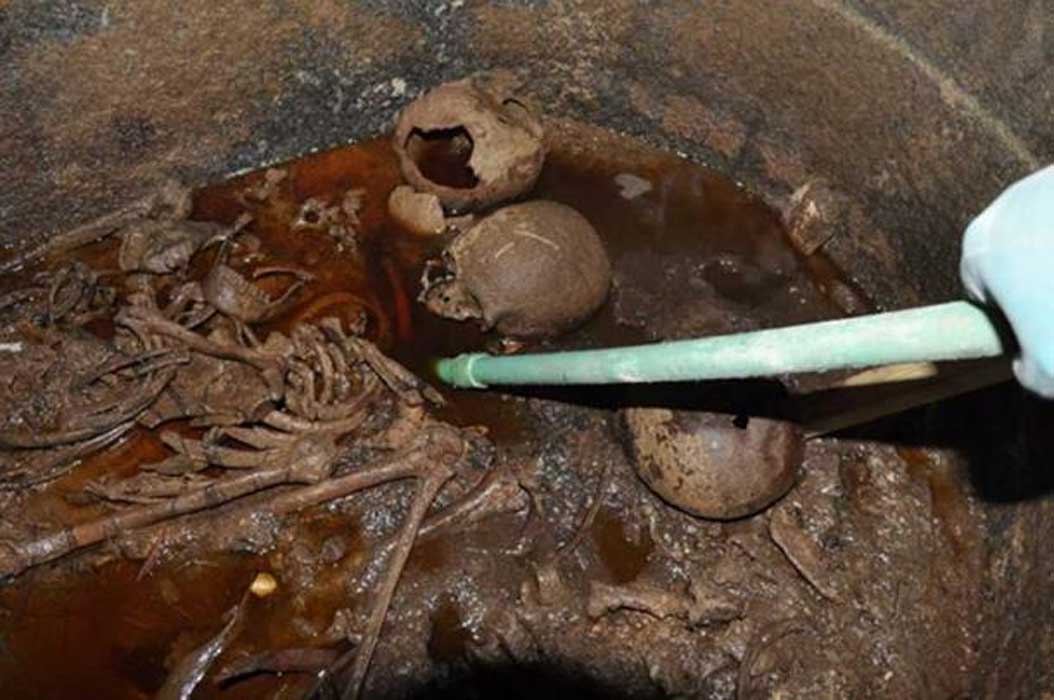Rotten Mummies of the Black Sarcophagus Begin the Identification Process
Dr. Mostafa Waziri, Secretary-General of the Supreme Council of Antiquities in Egypt announced on Sunday that a team of researchers headed by Dr. Zeinab Hashish, Director of the Department of Studies at the Ministry of Antiquities, discovered inside a large black granite sarcophagus, “three skeletons and a red liquid.” Initial guesses that the giant sarcophagus probably belonged to warriors seems unlikely after closer examination.
Although many had wished that the sarcophagus belonged to famed Macedonian king Alexander the Great, archaeological studies on the three skeletons from the approximately 2,000-year-old sarcophagus uncovered early last month in Sidi Gaber district in Alexandria, have identified the genders, ages and heights of the skeletal remains “through anthropological screening,” according to a report on Egypt independent.com.

Bones recovered from the black sarcophagus have now been recorded and undergone preliminary examination. (Image: Ministry of Antiquities)
Chief of the Egyptian Antiquities Sector Ayman Ashmawy said that a “Team of specialists extracted the remains from the flooded coffin and started to remove the dust and clay from the bones, gradually drying and then cleaning them. Specialists also documented, recorded, and took photos of the remains.”
Assessing of the remains in the black sarcophagus
The anatomy of “the skulls, pelvis and longitudinal bones” were subjected to anthropological examination which allowed the scientists to construct detailed personal profiles of the deceased Egyptians. Chief of the Central Administration of Antiquities in Lower Egypt, Nadia Khadr told reporters “The first skeleton was a woman aged between 20 and 25 years-old, and was between 160 and 164 cm. The second was a man aged between 30 and 35 years-old, measuring between 160 and 165.5 cm… The third skeleton was a man aged between 40 and 44 years-old” measuring around 184.5 cm. These statistics certainly have the makings of being a family burial.
- The Black Stone Sarcophagus is Open and Investigators Found More Than They Bargained For!
- New study reveals trepanation surgery in ancient Siberia
- Tomb of Alexander the Great already found, archaeologist claims, but findings have been blocked by ‘diplomatic intervention’

Initial anthropological assessment. (Image: Ministry of Antiquities)
Dr Hashish pointed out that the “right bone located on the back area” of one of the skulls has a rounded 1.7 cm (0.67 inch) wide cavity, resulting from surgery. Although the first reaction was that it might be the result of an arrow-wound, she assessed that this is probably evidence of trepanation - surgery where holes were drilled into the human skull: “This surgery is the oldest surgical intervention ever known since pre-history but was rare in Egypt,” Hashish said.

Evidence of trepanation on a skull. (Image: Ministry of Antiquities)
The long history of skull surgery
Known today as a craniotomy, the word trepanation comes from the Greek words “auger” or “borer” and describes the practice of scraping or drilling a hole into the cranial vault, exposing the brain’s dura mater, to relieve pressure and to remove skull fragments from the brain after a trauma. The first mention of trepanation was in the Hippocratic corpus, one of the world’s oldest surgical systems, however, albeit that the first ‘recording’ of trepanation was Greek, evidence tells archaeologists that throughout history, trepanation was practiced in Africa, South America, and the South Pacific.
In the 18th century trepanation was used to treat epilepsy and mental disorders, but because survival rates from the surgery were so poor due to hospital-acquired infections Victorian physicians “doubted that “primitive” cultures throughout history may have attempted the procedure,” according to a report in Brown Medicine Magazine.
This dogmatic attitude was tipped on its head when George Squier (1821-1888) acquired a trepanned skull from Peru and thought the hole in this skull was made by “an ancient American surgeon” during the patient’s life; however, members of the New York Academy of Medicine thought it had been drilled after death. Determined he was right, and against a tsunami of criticism, in 1867 Squier approached Paul Broca to examine his Peruvian skull.
- Inside Etemenanki: The Real-Life Tower of Babel
- Egyptian Alexandria - Ancient underwater finds revealed the Pharaonic roots of the Ptolemaic City
- False Door Tombstone and Array of Artifacts Unearthed in the City of Alexandria

A Nazca-Peruvian skull operation from 2000 years ago. (CC BY 2.0)
Paul Broca (1824-1880) was a respected French doctor for his work on the brain. Broca suggested that different parts of the brain had different functions and he developed a ‘cranial map’ using landmarks on the skull to identify corresponding parts of the brain. After sufficient testing Broca finally confirmed Squier’s trepanned Peruvian skull did indeed have ancient origins. With the coast clear, scientists began presenting trepanned skulls from across the globe, some dating back to the Neolithic period and earlier. It has now become clear that trepanation was attempted by many early societies across the globe, starting in the late Paleolithic period, around 10,000 years ago.

The three skeletons that have been recovered from the sarcophagus are 2 males and a female of varying ages. (Image: Ministry of Antiquities)
Further examinations
Dr. Waziri said that further studies are currently being carried out as well as “DNA tests and CT-scans on the bones of the skeletons” to search for any “familial relationship” according to an Egyptian Ministry of Antiquities report. Dr. Ayman Ashmawy, Head of the Ancient Egyptian Antiquities Sector pointed out that the strange red color of the water found inside the sarcophagus probably “resulted from the mixing of the sewage water that filled the sarcophagus with the remains of the skeletons’ wrappings which have been decomposed from the sewage water.”
Top image: The black sarcophagus was found to contain three skeletons and lots of sewage. Source: Ministry of Antiquities
By Ashley Cowie



















